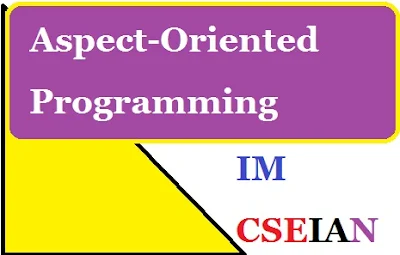Aspect-Oriented Programming
Abstract
The scenario so far suggests that it can be helpful to modularize the implementation of crosscutting concerns. Researchers have studied various ways to accomplish that task under the more general topic of "separation of concerns." AOP represents one such method. AOP strives to cleanly separate concerns to overcome the problems discussed above. AOP, at its core, lets you implement individual concerns in a loosely coupled fashion, and combine these implementations to form the final system. Indeed, AOP creates systems using loosely coupled, modularized implementations of crosscutting concerns. OOP, in contrast, creates systems using loosely coupled, modularized implementations of common concerns. The modularization unit in AOP is called an aspect, just as a common concern's implementation in OOP is called a class.
Description of Aspect-Oriented Programming
Object-oriented programming (OOP) has been presented as a technology that can fundamentally aid software engineering, because the underlying object model provides a better fit with real domain problems. However most software systems consist of several concerns that crosscut multiple modules. Object-oriented techniques for implementing such concerns result in systems that are invasive to implement, tough to understand, and difficult to evolve. This forces the implementation of those design decisions to be scattered throughout the code, resulting in "tangled" code that is excessively difficult to develop and maintain. The new aspect-oriented programming (AOP) methodology facilitates modularization of crosscutting concerns. Using AOP, you can create implementations that are easier to design, understand, and maintain. Further, AOP promises higher productivity, improved quality, and better ability to implement newer features.
Software design processes and programming languages exist in a mutually supporting relationship. Design processes break a system down into smaller and smaller units. Programming languages provide mechanisms that allow the programmer to define abstractions of system sub-units, and then compose those abstractions in different ways to produce the overall system. A design process and a programming language work well together when the programming language provides abstraction and composition mechanisms that cleanly support the kinds of units the design process breaks the system into.In the early days of computer science, developers wrote programs by means of direct machine-level coding. Unfortunately, programmers spent more time thinking about a particular machine's instruction set than the problem at hand. Slowly, we migrated to higher-level languages that allowed some abstraction of the underlying machine. Then came structured languages; we could now decompose our problems in terms of the procedures necessary to perform our tasks.
However, as complexity grew, we needed better techniques. Object-oriented programming (OOP) let us view a system as a set of collaborating objects. Classes allow us to hide implementation details beneath interfaces. Polymorphism provided a common behavior and interface for related concepts, and allowed more specialized components to change a particular behavior without needing access to the implementation of base concepts.




